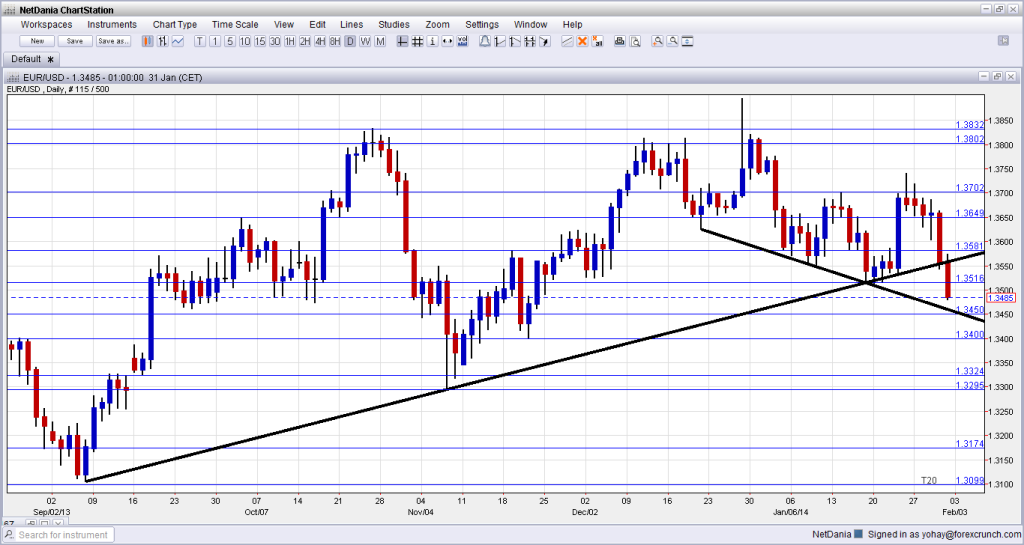EUR/USD had a negative week, losing nearly 200 pips and uptrend support. The ECB rate decision is the main event of the week. Will the ECB give the euro another push down?Also German industrial production and PMIs will have an impact, among other events. These are the main highlights for this week. Here is an outlook on the major events and an updated technical analysis for EUR/USD.
The annual inflation rate in Germany dropped to 1.3% in January, Also the euro-zone inflation rate dropped again to the bottom of 0.7%. With the threat of deflation, will the ECB act now, or wait for March? On the upside, German employment market surprised with a sharp drop of 28,000 in the number of unemployed, beating forecast for a 5,000 fall. In the US, the Fed announced a second tapering and growth came out at a solid 3.2%, even though not all is rosy. What direction will we see now? Let’s start:
[do action=”autoupdate” tag=”EURUSDUpdate”/]EUR/USD daily chart with support and resistance lines on it. Click to enlarge:
- Manufacturing PMIs: Monday. The Eurozone Manufacturing sector improved considerable from November, confirming the euro-area is on the right track to recovery. The headline reading reached 52.7 in line with market forecast compared to 51.6 achieved in November. This was the highest reading in 2.5 years. Italian manufacturing edged up 1.5 points to 53.3, beating expectations for a 51.3 reading, raising optimism about positive growth in 2014. Spanish manufacturing rebounded in December posting 50.8 compared to 48.6 in November indicating expansion. Manufacturing activity is expected to improve further with Spain reaching 51.3, Italy climbing to 54.2 and the Eurozone is expected to reach 53.9.
- Spanish Unemployment Change: Tuesday, 8:00. Spanish jobless claims declined sharply in December amid a boost in hiring for shops and other service sector preparing for the holiday season. Jobless claims edged down by 107,570, the biggest December drop on record, and the second biggest of any month on record, offering hope for a recovery process in 2014. However, Spain continues to have the second-highest unemployment rate in Europe. Over the last 12 months, the number has fallen by 147,385. Another decline of 21,300 is expected in the number of unemployed.
- Italian CPI: Tuesday, 10:00. Italy’s consumer prices increased by 0.2% in December, following a 0.4% decline in November. Prices were decelerating across the board, indicating weak economic activity. Prices for transport services rose 1.2% over the year against a 6.5% rise in 2012, housing and utilities prices rose 2 percent against a 7.1 percent rise in the previous year and food prices rose 2.2% against 2.6% the previous year. Another rise of 0.3% is forecast this time. Italian CPI will have an impact on the final euro-zone CPI for January.
- Services PMIs: Wednesday. Eurozone services advanced at the slowest pace in four months. Ongoing domestic sluggishness in some member-states continued to weigh on recovery toward the end of 2013. Eurozone services declined from 51.2 to 51.0 in December still signaling expansion. Spain registered the biggest leap in six years, reaching 54.2 compared to 51.5 in the previous month, but Italy continued to contract posting 57.9 in December following 57.2 in November. Nevertheless the PMI’s suggest that Eurozone recovery has gathered momentum at the end of 2014. Services sectors in Spain and Italy are expected to improve further with Spain reaching 55.3 and Italy advancing to 48.2 though still in contraction and the Eurozone is expected to reach 51.9.
- Retail Sales: Wednesday, 10:00. Euro zone retail sales soared in November beating expectations by climbing 1.4%, following 0.4% decline. Analysts expected a minor increase of 0.2%. In November, sales in the food, drinks and tobacco sector were up 1.1% m/m and 1.4% y/y while turnover in the non-food sector rose by 1.9% m/m and 2.4% y/y. Euro zone retail sales are expected to decline 0.7% this time, after Germany reported a surprising drop of 2.5%.
- Retail PMI: Thursday, 9:10. The Eurozone retail PMI continued to slide for the fourth month running, falling to 47.7 from 48 in November, showing strong contraction in France and slower growth decline in Germany. Eurozone retail PMI data are based on the three largest Eurozone economies; Germany rising for the eighth month running in December, France downturn increased, as sales fell for the fourth successive month and Italy continued to post the sharpest decline in sales of the three economies. Nevertheless, these declines were lower than in previous months.
- German Factory Orders: Thursday, 11:00. German factory orders advanced by 2.1% in November 2013, suggesting Europe’s largest economy is on a solid recovery path for 2014. The boost in orders came both from domestic market and abroad. Economists believe German economy will recover in a faster pace in 2014 as well as contribute to the Eurozone’s recovery. An increase of 0.3% is expected now.
- Eurozone rate decision: Thursday, 12:45, press conference at 13:30. The ECB will likely leave its policy unchanged, but could certainly set the ground for a negative deposit rate in March. Inflation continues to fall in Germany and in the euro-zone. It will be harder for Draghi and co. to deny the danger of deflation, and it will be harder to wave with a negative deposit rate and not use it eventually. In the press conference, he could use words to hint an imminent cut of both the main lending rate and the deposit rate in March, and this would hurt the euro..
- German Trade Balance: Friday, 7:00. Germany’s trade surplus increased in November to a near record of 17.8 billion euros evoking criticism among euro-zone partners that Germany is not spending enough to help out its struggling neighbors. The reading was 24.2 billion euros higher than in the previous month due to a 0.3% rise in exports. The United States, tried to urge Germany to spend more, while the International Monetary Fund has said a smaller surplus is the only way reduce imbalances that plague the Eurozone. Germany’s trade surplus is predicted to narrow to17.3 billion euros.
- German Industrial Production: Friday, 11:00. German industrial production expanded more than expected in November climbing 1.9%, following a 1.2% decline in October, suggesting Germany is rebounding. The increase topped predictions of a 1.6% increase suggesting a solid recovery trend. Furthermore German business confidence skyrocketed in December indicating German people are confident in Germany’s recovery. German central bank Bundesbank projected that the German economy would expand by 0.5% in 2013 and by 1.7% in the New Year. Another advance of 0.5% is predicted this time.
* All times are GMT
EUR/USD Technical Analysis
Euro/dollar began the week with a struggle around the 1.37 line (mentioned last week). From there it dropped sharply, initially clinging on to support at 1.3515, but then falling even lower to close at 1.3485.
Technical lines from top to bottom:
We start from lower ground this time. 1.38 is a round number and also worked as a temporary cap during that period of time and also in October 2013. Another round number, 1.37, is another resistance line after capping the pair in December.
1.3650 provided support in December and worked as resistance in September 2013, and is also a significant line. Below, 1.3580 worked in both direction in the winter of 2013-14.
The January 2014 low of 1.3515 provides minor support on the way down. 1.3450 worked as resistance in August 2013 and as support in September and October. It is now a key line on the downside.
The round number of 1.34 worked as resistance several times in 2013, and is strengthening now. 1.3320 worked as a double top in early September and it was crossed only with a Sunday gap. It remains a clear separator of ranges.
It is closely followed by 1.3295, which was the bottom in November and is part of the broken trend line. 1.3175 capped the pair during July 2013.
1.3100 is worked as temporary resistance in December 2012 and is becoming more important once again, after capping a recovery attempt in June and then in July and providing support in September. Below, 1.3050 is minor support after holding the pair in August 2013.
The last line for now is 1.30, which is a very round number and also worked as support many times in the past.
Long term uptrend support broken, downtrend support emerging
A line beginning in the lows of early September that was connected to a line in November gave support to EUR/USD for some time, but was now convincingly broken.
Downtrend support that began in December and was formed in January is getting closer now.
I remain bearish on EUR/USD
The danger of deflation is now getting closer to center stage but is not fully priced in. While the ECB is likely to hold its fire and not use the “nuclear option” of a negative deposit rate just now, there is an excellent chance of dovish language and a good chance of a thick hint to set a negative deposit rate in March. A negative deposit rate will likely scare money from the euro-zone.
Across the Atlantic, it seems that the Fed now needs really bad news in order to stop the taper train. And the US economy is still growing nicely. The weak NFP seen for December will likely be corrected now, and will leave the stage for Europe.
More:
- EURUSD: Hesitates Above Its Key Support
- EUR$ turns bearish as it approaches 2-month low, Fed tapering weighs
If you are interested a different way of trading currencies, check out the weekly binary options setups, including EUR/USD and more.
Further reading:
- For a broad view of all the week’s major events worldwide, read the USD outlook.
- For the Japanese yen, read the USD/JPY forecast.
- For GBP/USD (cable), look into the British Pound forecast.
- For the Australian dollar (Aussie), check out the AUD to USD forecast.
- USD/CAD (loonie), check out the Canadian dollar forecast
- For the kiwi, see the NZDUSD forecast.

